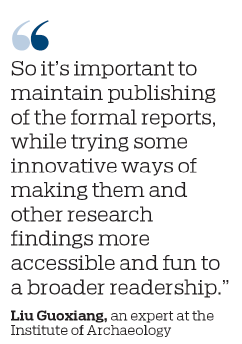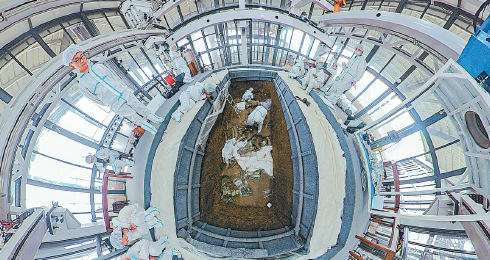Digging up publicity
Books to record surge in interest around excavations as important findings whet public's appetite, Mei Jia reports.
Just a week before exciting findings, including a golden mask, were announced at the Sanxingdui Ruins site in Guanghan, Sichuan province, a leading publishing house decided to set up an archaeology workshop to help record achievements and provide resources for more to study.
"Since the beginning of the millennium, there has been a surge of new excavations, and the number of large-scale digging sites are rising in the country," says Zhao Jianying, president of the China Social Sciences Press, part of the Chinese Academy of Social Sciences.
"We feel obliged and responsible to take up the task of presenting them in book form, as well as in other ways," Zhao says.
The press is known for its previous publications of tomes like the nine-volume Chinese Archaeology. Zhao says the press has published hundreds of titles on archaeology since its establishment in 1978, among which were award-winners such as those honored with the Chinese Government Award for Publishing.
"With our author base and editorial strength, the new workshop is set to open up a broader horizon for the study of archaeology," Zhao says."We'll input more funds and more personnel."
The workshop is a response to President Xi Jinping's call to develop archaeology to better understand Chinese civilization during a meeting in September 2020, Zhao says.
"Xi called for strengthened dissemination of archaeological and historical research findings through an in-depth study of history. He urged further efforts to guide the people, especially young people, to better understand the origin and development history of Chinese civilization," says a Xinhua report.
Wang Wei, with the Institute of Archaeology, and chairman of the Chinese Archaeological Society, is leading a project on the publication of a centennial history of Chinese archaeology, involving more than 100 leading experts in archaeology.
All the important discoveries will be described by archaeologists who actually worked on the exact sites, making sure they're authoritative and firsthand, according to Guo Peng, director of the workshop under the press.
Guo notes that the advanced technology the archaeologists are applying, including remote sensing and carbon-14 testing, is another aspect the book addresses.
Wang says the book in progress, "a comprehensive and complete record", will be one of the workshop's first achievements.
Wang also hopes the press and its international publishing partners will make Chinese archaeological titles more visible and influential globally.
Another book the workshop is doing is about national treasures."It will be an easy-reading photo album covering volumes on jade, copper, ceramic wares and more,"Guo says.
Zhao mentions Chinese archaeological studies are trending toward meticulous, refined and diversified development. It begins to merge with multiple sciences, and stresses excavating as well as protection, with considerations on exhibition being included in advance.
Liu Guoxiang, with the Institute of Archaeology, says contemporary archaeological research is closely related to the source of Chinese civilization and how Chinese people see their roots and culture.
Liu adds that there are about 160,000 people nationwide involved in museums and the cultural relic sector, among which about 7,000 are archaeological professionals working onsite. The archaeology reports they publish on average have a print run of 1,500 to 2,000 copies, and the audience is limited because it's not easy for general readers to get through the reports.
"So it's important to maintain publishing of the formal reports, while trying some innovative ways of making them and other research findings more accessible and fun to a broader readership," Liu says.
He suggests digital three-dimensional images of the relics unearthed. Even a senior archaeologist like Liu, doesn't have access to some of the items needed in research. The digital images would be of great help.
Liu, who oversees some of China Central Television's archaeology-themed popular programs, knows the attraction of multimedia presentations. He also hints the possibility of publishing the multimedia products for the workshop under the press.
"Books and e-publications are handy in promoting the public awareness and knowledge in archaeology, now that interest regarding archaeology is rising," he adds.
Contact the writer at meijia@chinadaily.com.cn
















